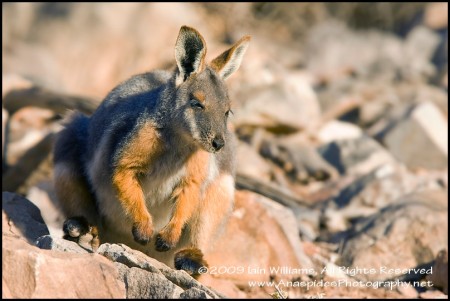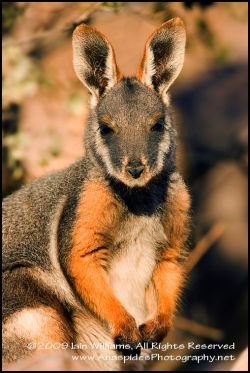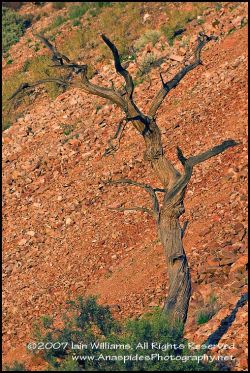Low Light, Talus and Yellow Foots (Yellow-footed Rock Wallabies)
 Wednesday, April 15, 2009 at 3:35PM
Wednesday, April 15, 2009 at 3:35PM  The sun is beginning sink toward the horizon and "golden hour" is fast approaching as I make my way to the base of the talus slope. The yellow foots migrate down from the cliffs to feed on vegetation (grass heads and flowers) which grow at the base of the slope and in the dry watercourse.
The sun is beginning sink toward the horizon and "golden hour" is fast approaching as I make my way to the base of the talus slope. The yellow foots migrate down from the cliffs to feed on vegetation (grass heads and flowers) which grow at the base of the slope and in the dry watercourse.
The terrain in this area is not flat or even undulating. It is a 600 foot talus slope which progrades at the upper end to steep cliffs with rock shelters and overhangs, whilst at the lower end a dry water course meanders along the base. In between are loose rocks, boulders, and a species of cassarina tree (in the lower reaches). The wallabies spend their days in the safety of the higher cliff face, safe from the searching eyes of predators, such as wedge-tailed eagles.
 This species of wallaby is endangered and can usually only be observed very late in the afternoon and during the very early morning - in only a few places in Australia.
This species of wallaby is endangered and can usually only be observed very late in the afternoon and during the very early morning - in only a few places in Australia.
If you want to photograph yellow foots in the wild, in their natural environment, you have little choice but to scale the talus slope. This on a normal day is difficult, now add 2 camera bodies, 3 lens and a tripod and see how you go! A missed step on a talus slope means expensive camera equipment broken and maybe a fractured ankle or wrist - needless to say care is required.
After a short climb in which I was desperately attempting to be quiet, but failing as rocks kept moving and clinking together as I made my way across them, I saw my quarry. Well, to be truthful they saw me first!
The yellow footed rock wallaby has a beautiful fur coat of orange, white and rufus brown colours. It also sports a very long tail which is coloured and textured like a tiger's coat - stripes. At the end of the tail is a ball of tuffy fur. The tail is an important aspect of the rock wallabies biology; without the tail, the wallaby would not be able to balance as it does precariously on rocks and cliffs.
Banishing these colours you would think that a yellow foot would be easy to see - guess again!
 Despite it's striped tail looking like a warning sign on a highway, these critters blend in amazingly with their environment. The yellow and brown colours match the rocks they inhabit - and during low morning and afternoon light, when the rocks glow bright orange and red, and the animals are most active, they blend into their surroundings.
Despite it's striped tail looking like a warning sign on a highway, these critters blend in amazingly with their environment. The yellow and brown colours match the rocks they inhabit - and during low morning and afternoon light, when the rocks glow bright orange and red, and the animals are most active, they blend into their surroundings.
The image left gives you a pretty good idea of the terrain. The talus slopes is very extensive and the yllow foots bound accross it at almost break neck speed when they have to. Otherwise, they just crawl down the slope using their exceptionally strong tails for support.
As you can see from the colours, in low light this environment just explods into colour.



Reader Comments (1)
Looks like a complete study in orange... beautiful light down there.